Reviewed by Danielle Ellis, B.Sc.Oct 9 2024
In a study published in Science, researchers from the University of California, Irvine, and other international institutions have observed grain rotation in polycrystalline materials at the atomic scale for the first time.
 “Scientists have speculated and theorized on phenomena occurring at the boundaries of crystalline grains for decades, but now – through the use of the most advanced instruments available to the scientific community – we have been able to transition from theory to observation,” says Xiaoqing Pan, UC Irvine Distinguished Professor of materials science and engineering and director of the UC Irvine Materials Research Institute. He’s lead author of a paper in Science on direct observations of grain rotation in polycrystalline materials. Image Credit: Steve Zylius / UC Irvine
“Scientists have speculated and theorized on phenomena occurring at the boundaries of crystalline grains for decades, but now – through the use of the most advanced instruments available to the scientific community – we have been able to transition from theory to observation,” says Xiaoqing Pan, UC Irvine Distinguished Professor of materials science and engineering and director of the UC Irvine Materials Research Institute. He’s lead author of a paper in Science on direct observations of grain rotation in polycrystalline materials. Image Credit: Steve Zylius / UC Irvine
These materials have long been researched for their special qualities and structural dynamics, and they are widely used in solar energy systems, electronic devices, automotive applications, and aerospace technologies.
The UC Irvine Materials Research Institute's cutting-edge microscopy equipment allowed researchers to heat samples of platinum nanocrystalline thin films and view the mechanism causing grain rotation in previously unattainable detail.
Advanced methods like high-angle annular dark-field STEM and four-dimensional scanning transmission electron microscopy were used in the study. The authors created a novel machine learning-based algorithm to extract important information from the massive 4D-STEM datasets to overcome the difficulty of interpreting them.
Direct, real-time views of the atomic processes involved were made possible by these potent imaging and analysis tools, which particularly highlighted the significance of disconnections at grain boundaries.
Scientists have speculated and theorized on phenomena occurring at the boundaries of crystalline grains for decades, but now – through the use of the most advanced instruments available to the scientific community – we have been able to transition from theory to observation.
Xiaoqing Pan, Study Lead Author and Distinguished Professor, University of California, Irvine
The interfaces between individual crystal grains in polycrystalline materials, known as grain boundaries, are known to contain imperfections that may affect efficiency and conductivity.
The researchers found that disconnections, which are line defects with both step and dislocation characteristics, propagate along the grain boundaries in these materials, causing grain rotation. This breakthrough significantly improved our understanding of the microstructural evolution of nanocrystalline materials.
The study also demonstrated, for the first time, a statistical relationship between grain rotation and grain growth or shrinkage using data analysis aided by machine learning. According to atomistic simulations and STEM observations, this relationship results from shear-coupled grain boundary migration that is fueled by disconnection motion. This discovery is crucial because it sheds light on the basic processes underlying grain rotation and provides an understanding of the dynamics of nanocrystalline materials.
“Our results provide unequivocal, quantitative and predictive evidence of the mechanism by which grains rotate in polycrystals on an atomic scale. Understanding how disconnections control grain rotation and grain boundary migration processes can lead to new strategies for optimizing the microstructures of these materials. This knowledge is invaluable for advancing technologies in various industries, including electronics, aerospace and automotive sectors,” Pan, who is also a professor in UC Irvine’s Department of Physics & Astronomy, a Henry Samueli Endowed Chair in Engineering, and director of the UC Irvine Center for Complex and Active Materials, added.
The study presents new opportunities to enhance polycrystalline materials' performance and dependability, increasing their durability and efficiency for a variety of uses.
Yutong Bi, Ying Han, Yuan Tian and Mingjie Xu of UC Irvine; Xiaoguo Gong and David Srolovitz of the University of Hong Kong; Leonardo Velasco Estrada of Colombia National University; Evgeniy Boltynjuk of Germany’s Karlsruhe Institute of Technology; Horst Hahn of the University of Oklahoma; and Caihao Qiu and Jian Han of City University of Hong Kong collaborated on this project with Pan.
The National Science Foundation’s Materials Research Science and Engineering Centers program, the US Army Research Office, and the Hong Kong Research Grants Council supported this study.
Journal Reference:
Tian, Y. et. al. (2024) Grain rotation mechanisms in nanocrystalline materials: Multiscale observations in Pt thin films. Science. doi.org/10.1126/science.adk6384